Author: DappRadar
Compiled by: Felix, PANews
In February, Web3 trends shifted, with AI, gaming, and social dapps still growing despite a slight drop in overall activity. DeFi faced a sharp decline, with overall NFT trading volume falling despite strong momentum for AI-driven and sports NFTs. The month also set a record for crypto hacks, highlighting the need for increased security measures.
Key Points
- Dapp activity cooled, with daily unique active wallets (dUAW) falling 8% to 24 million, but users of AI, social, and NFT grew.
- NFT trading volume plunged 50% to $498 million, reflecting the broader market downturn, but AI-driven and sports NFTs showed strong momentum.
- DeFi suffered a major decline, with TVL shrinking from $217 billion to $168 billion, with Ethereum and Solana leading the decline due to capital outflows and liquidity shifts.
- Berachain became the fastest growing DeFi chain with a TVL of $5.05 billion.
- AI-driven dapp adoption has surged, with some platforms seeing growth rates exceeding 700%, solidifying AI’s dominance as the fastest-growing sector of Web3.
- In February, the amount of money stolen from crypto hacker attacks hit a record high of $1.5 billion, mainly due to the hack of the Bybit exchange ($1.4 billion), which was the largest attack in history.
Web3 activity declines, but AI , NFT , and social sectors buck the trend
Following a strong rise in January, Dapp activity cooled slightly in February. The total number of daily unique active wallets (dUAW) across all tracked dapps is estimated to have fallen by 8%, stabilizing at around 24 million.
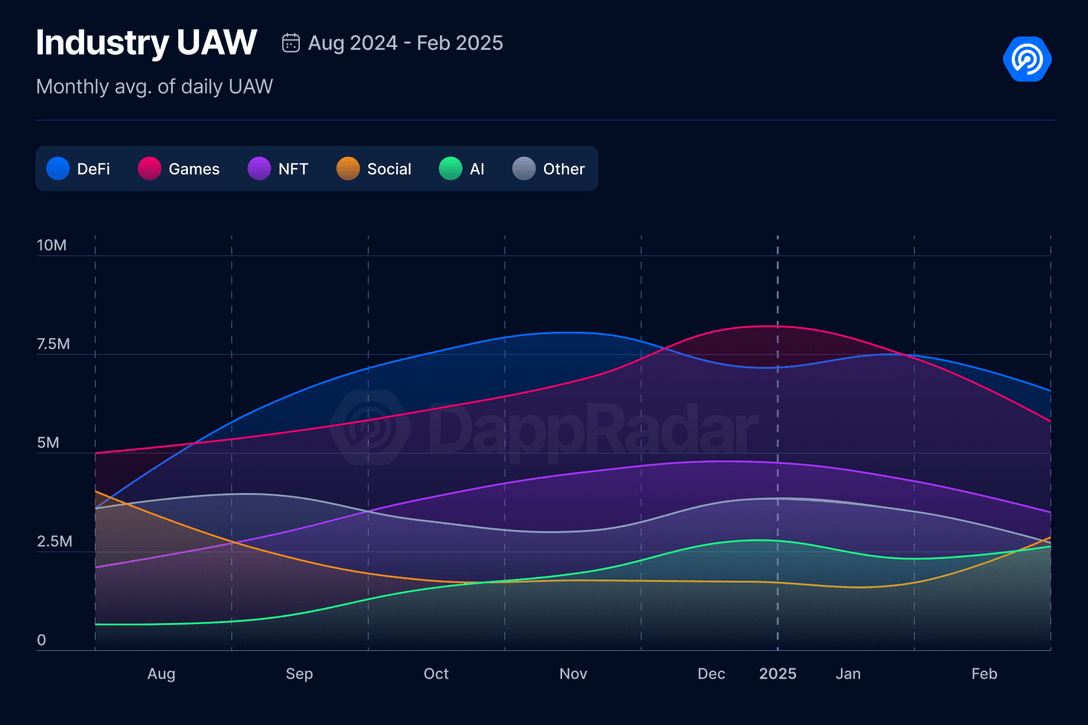
Despite a decline in overall activity, DeFi still dominates with the largest share of users. About 27% of active wallets in February were related to DeFi applications, consolidating its position as the most used dapp category. However, not all areas followed the downward trend, with social, NFT, and AI all seeing growth, indicating that user interests are constantly changing.
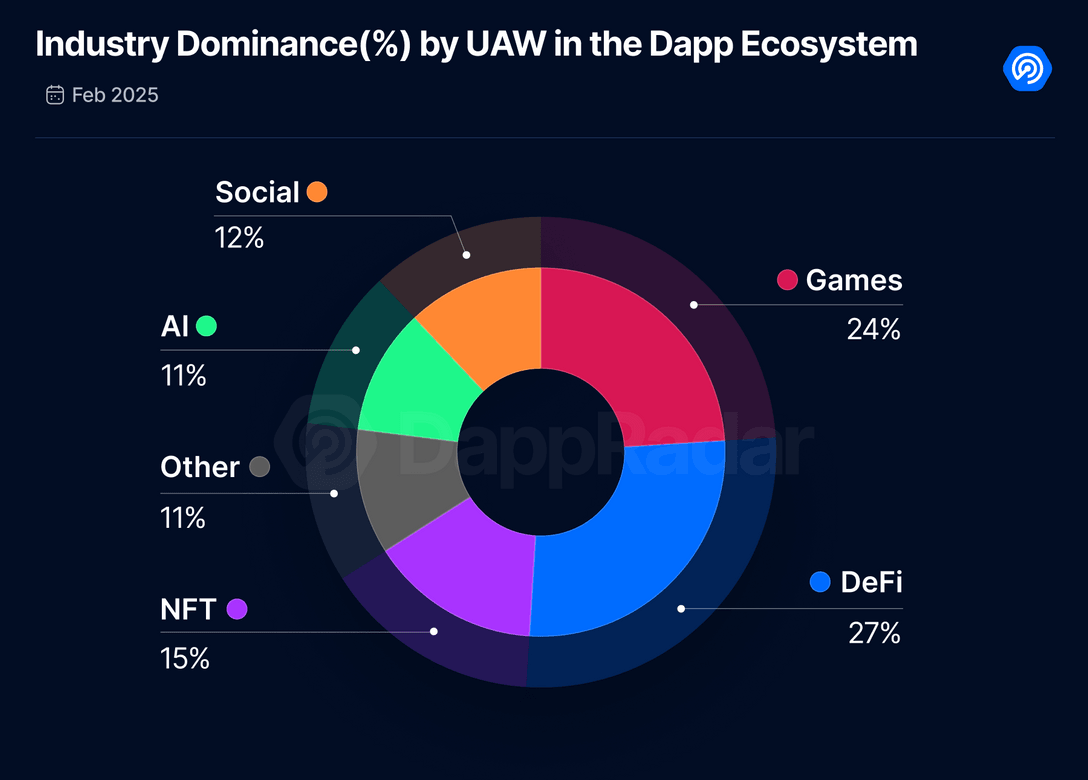
Social dapps grew 9% to 2.8 million daily unique active wallets (dUAW), while NFT activity grew 6% with 3.5 million users interacting with NFT platforms. AI was once again the fastest growing sector, soaring 16% to 2.6 million dUAW.
From a blockchain perspective, Solana maintains its lead in on-chain activity, with the most unique active wallets (UAW) and number of transactions. This continued participation reflects the growing appeal of gaming dapps and memecoins that continue to launch on the network, making it the epicenter of emerging trends.
Abstract stood out, with UAW (independent active wallets) growing 1093%.
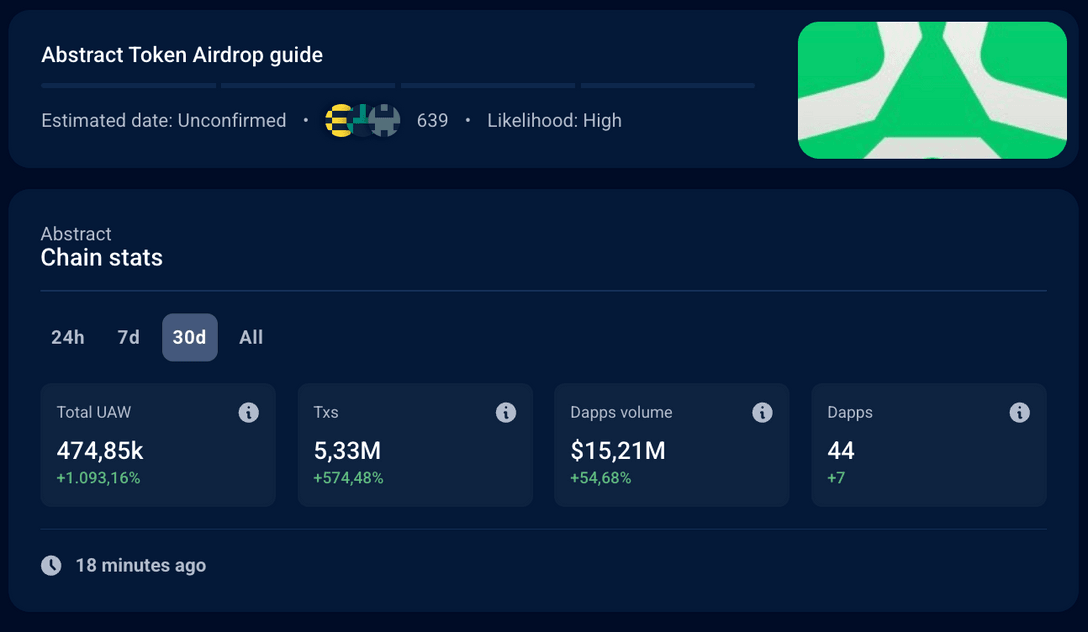
Hot dapps : Changing trends in Web3 adoption
Analyzing the top dapps by active wallet count in February reveals several key trends that highlight the evolving Web3 landscape.
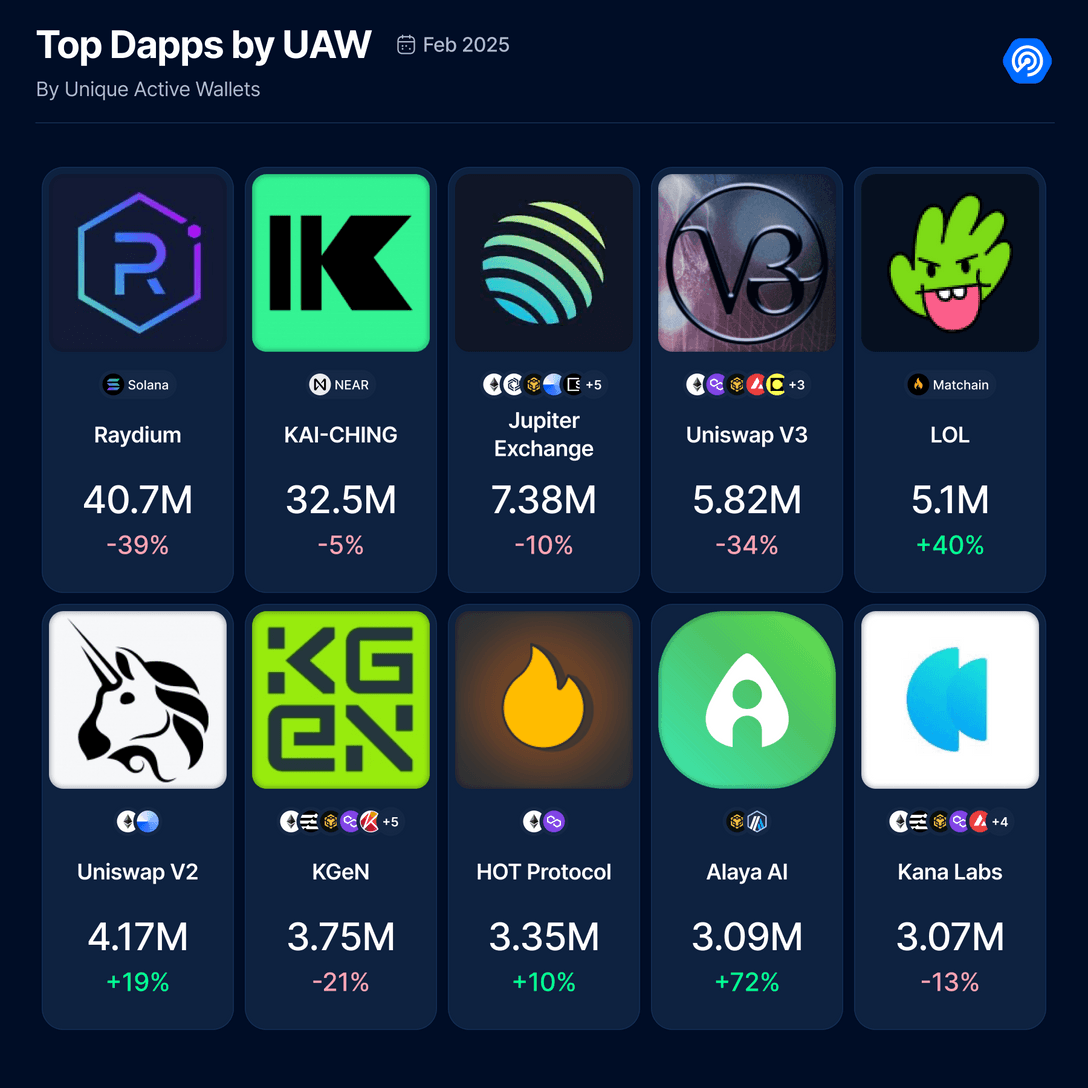
Solana and NEAR continue to dominate in terms of user activity, maintaining their lead despite minor fluctuations. Their dapps continue to attract a large number of users, solidifying their position as the preferred platforms for developers and users.
Gaming and AI are becoming the most dynamic sectors, with adoption rates rising significantly. Gaming dapp LOL saw a 40% increase in UAW (unique active wallets), while Alaya AI saw a 72% increase, highlighting the growing demand for AI-driven Web3 experiences and interactive gaming platforms.
In DeFi, user behavior indicates a shift in priorities. Usage of Uniswap V3 has declined, while activity on Uniswap V2 has increased, suggesting that traders are optimizing for cost efficiency in their trades.
At the same time, emerging chains began to gain attention, bringing new competition to the dapp industry. For example, Matchain entered the market strongly, and LOL took the lead on this platform.
As Web3 continues to expand, these trends suggest that decentralized applications will become more integrated into daily digital life in the future.
DeFi faces market volatility as new chains emerge
The DeFi space suffered a sharp decline in February, with TVL plummeting from $217 billion to $168 billion. This decline reflects broader market volatility, capital outflows, and liquidity changes that have affected both mainstream and emerging DeFi ecosystems.
The Ethereum network, the backbone of DeFi, saw its TVL fall by 27% to $97 billion, but still account for more than 57% of total liquidity. The decline was mainly due to reduced liquidity in the Liquidity Staking Protocol, which had previously been the main growth driver. Despite the market downturn, Ethereum's position remains unshakable.
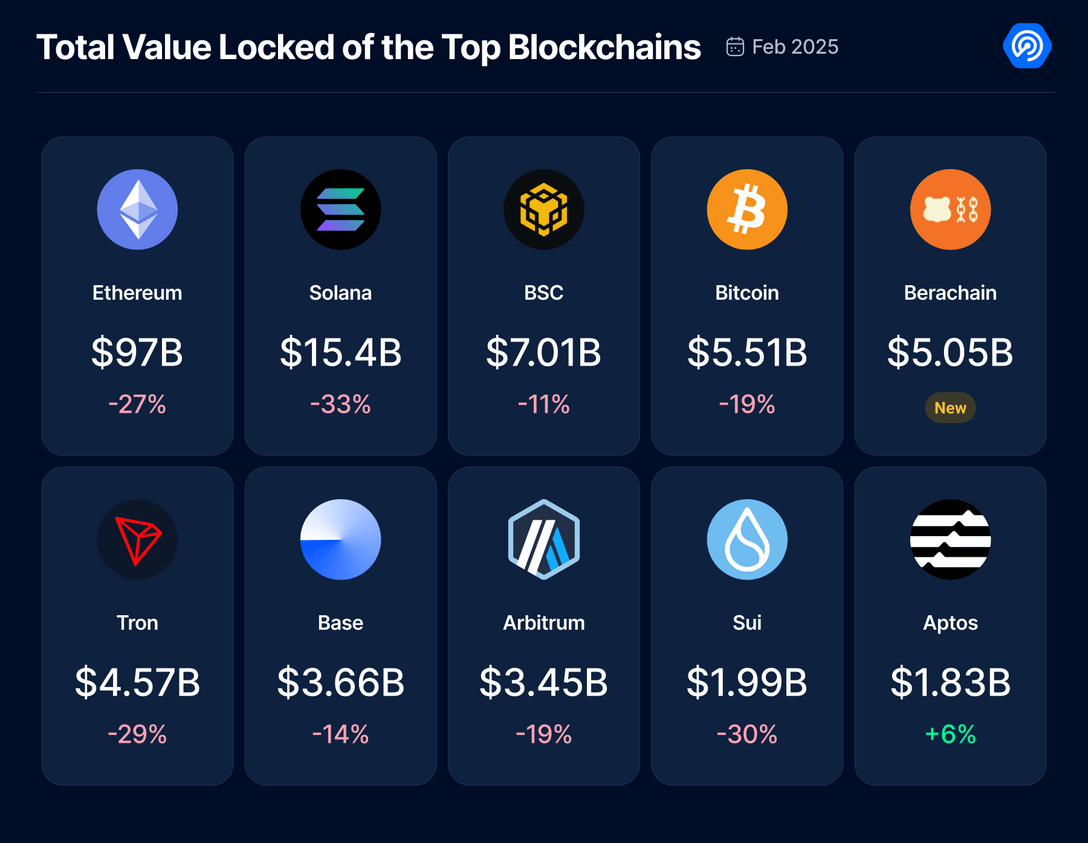
Solana suffered the biggest drop, with its TVL falling 33% to $15.4 billion. After a strong January, the decline may be attributed to profit-taking and the migration of liquidity to more stable DeFi. The decline was further exacerbated by reduced user activity on protocols such as Jupiter Exchange (UAW down 10%) and Raydium (UAW down 39%), indicating reduced trading volume and liquidity supply.
Meanwhile, Berachain has emerged as one of the fastest-growing DeFi ecosystems, with a TVL of $5.05 billion. The chain’s rise is due to its liquidity proof model, which attracts users through lucrative liquidity staking and yield farming incentives. As users seek high returns amid a general market decline, Berachain has positioned itself as a key player in the evolving DeFi landscape.
Other notable trends include BNB Chain and Tron, both of which play key roles in stablecoin-based DeFi. BNB Chain's TVL maintained a relatively mild 11% decline as stablecoin trading and lending continued to support liquidity. However, Tron fell 29%, indicating a decline in demand for USDT trading and a general decline in on-chain stablecoin settlements. In stark contrast to the overall DeFi downturn, Aptos stood out with its TVL growing 6% to $1.83 billion.
Fastest growing sector: AI dapps surge
February marked a significant milestone for AI-driven dapps as participation surged across multiple sectors, reinforcing the growing synergy between AI and blockchain technologies. Users increasingly explored social, gaming, and DeFi applications that integrated AI, driving a significant uptick in adoption. Unique Active Wallets (UAWs) for AI-driven dapps surged, with some platforms increasing by more than 700% in a month, proving the accelerating growth of AI’s influence in the decentralized space.
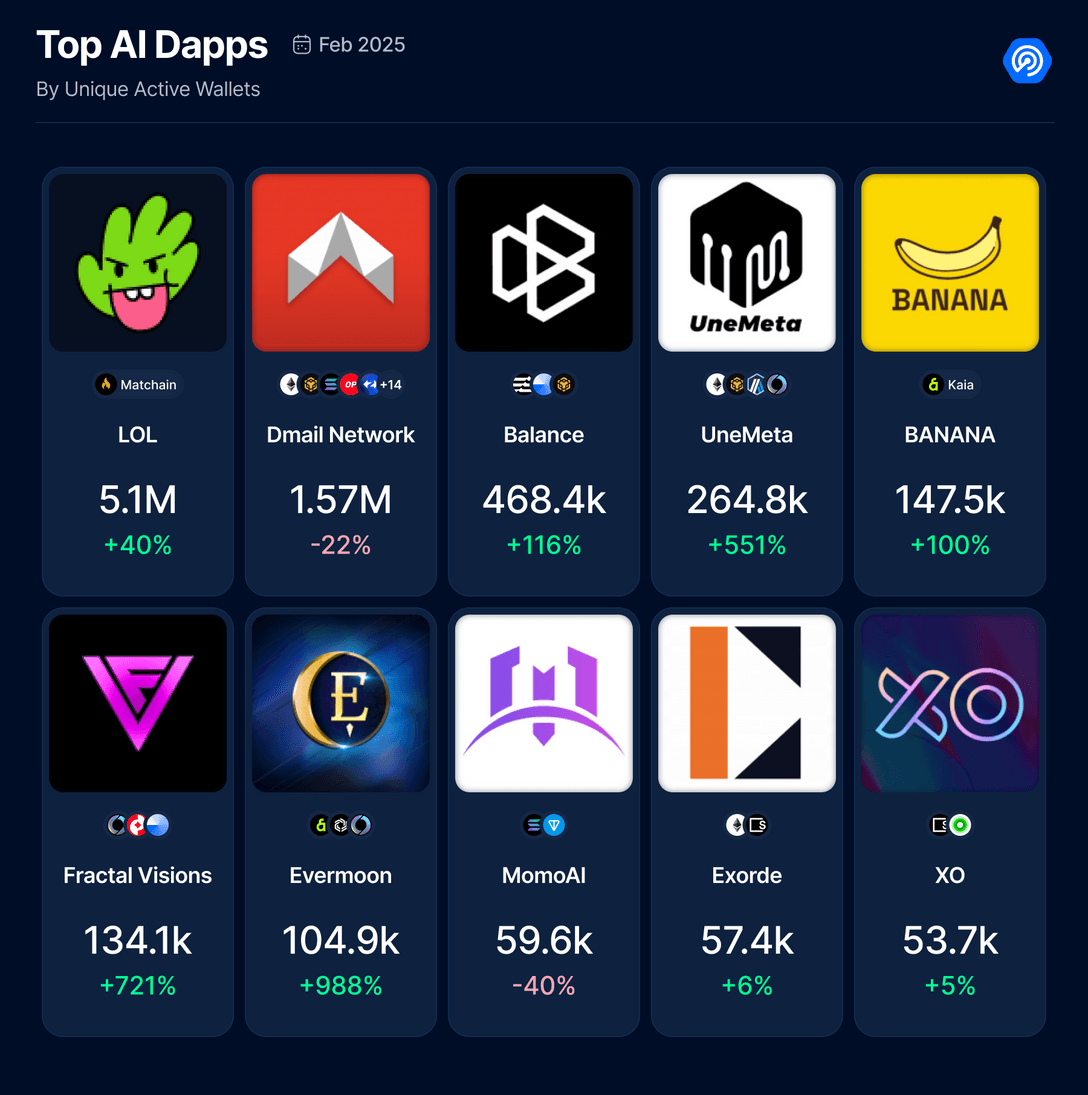
Among the standout applications, LOL became the most used AI dapp, attracting 5.1 million UAWs, up 40%, thanks to its AI-driven interactive social features on Matchain. Meanwhile, Evermoon and UneMeta achieved growth of +988% and +551% respectively, highlighting the growing demand for AI-driven games and NFT platforms. AI-generated art and creative tools are also becoming more popular, with Fractal Visions growing 721%, demonstrating the growing popularity of AI-generated NFTs.
The role of AI in financial and social applications is also expanding. Balance uses AI to optimize financial decisions and community interactions, and its user base grew 116% in February. Although some platforms have declined, such as Dmail Network (-22%) and MomoAI (-40%), the overall AI field is still the fastest growing category in Web3.
NFT market suffers as market downturn hits, but AI and sports series shine
The crypto market downturn has also affected the NFT sector. Although NFT has been showing signs of recovery in recent months, its momentum has slowed since the beginning of the year. In February, total NFT trading volume fell to $498 million, a 50% drop from the previous month. As expected, the correlation between cryptocurrency prices and NFT valuations remains strong, and market sentiment has caused fluctuations in trading activity.
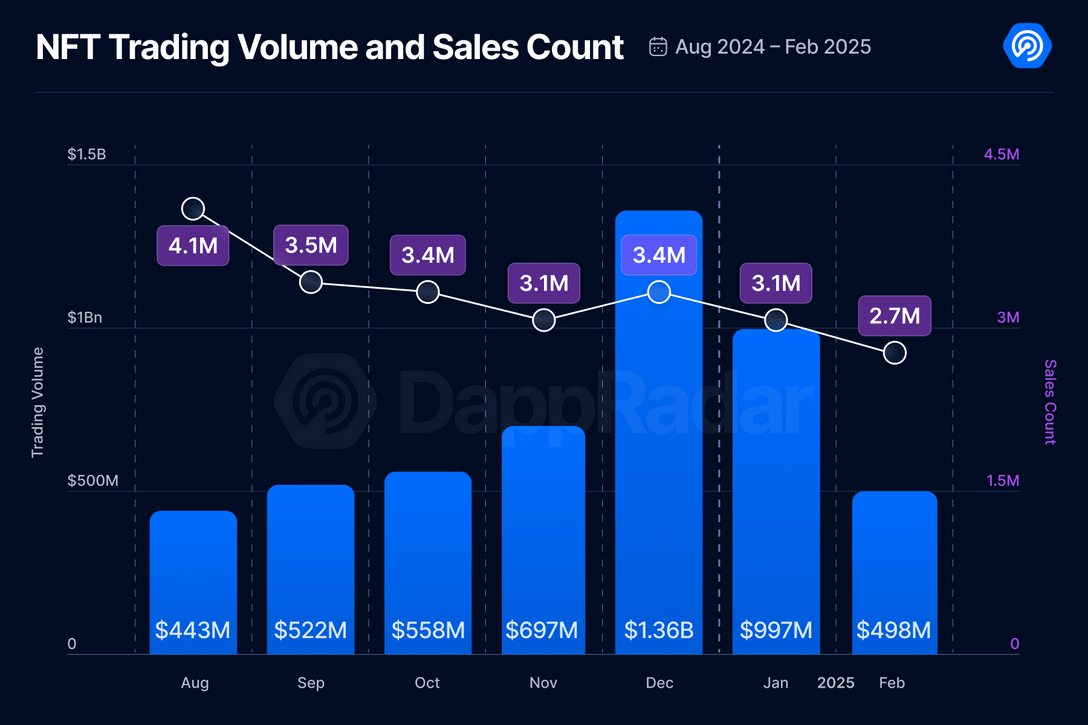
Despite the market downturn, Pudgy Penguins remains one of the most active NFT series. Although its trading volume has declined, the number of transactions has increased by 25%, indicating strong trading activity at lower prices. Meanwhile, Doodles' trading volume has increased significantly, thanks to its announcement that it will launch a new token DOOD on Solana.
The new leader in the NFT space is Kaito Genesis, an AI series powered by Kaito AI, a digital asset search engine designed to democratize crypto information. Launched in December 2024, the series consists of 1,500 unique NFTs on Ethereum and surged in February, reaching an all-time high of 7.65 ETH. The rise was driven primarily by strategic collaborations, including a partnership with the Azuki NFT team to integrate AI capabilities into their ecosystem.
Another project that stood out this month was Courtyard's Tokenized Collectibles, an innovative project that connects physical collectibles and digital assets. Developed by Courtyard.io, the platform allows collectors to tokenize real-world items by storing them in vaults operated by Brink and minting them as NFTs on Polygon. This fusion of physical and digital assets represents a unique development in the NFT space, catering to both traditional collectors and Web3 enthusiasts.
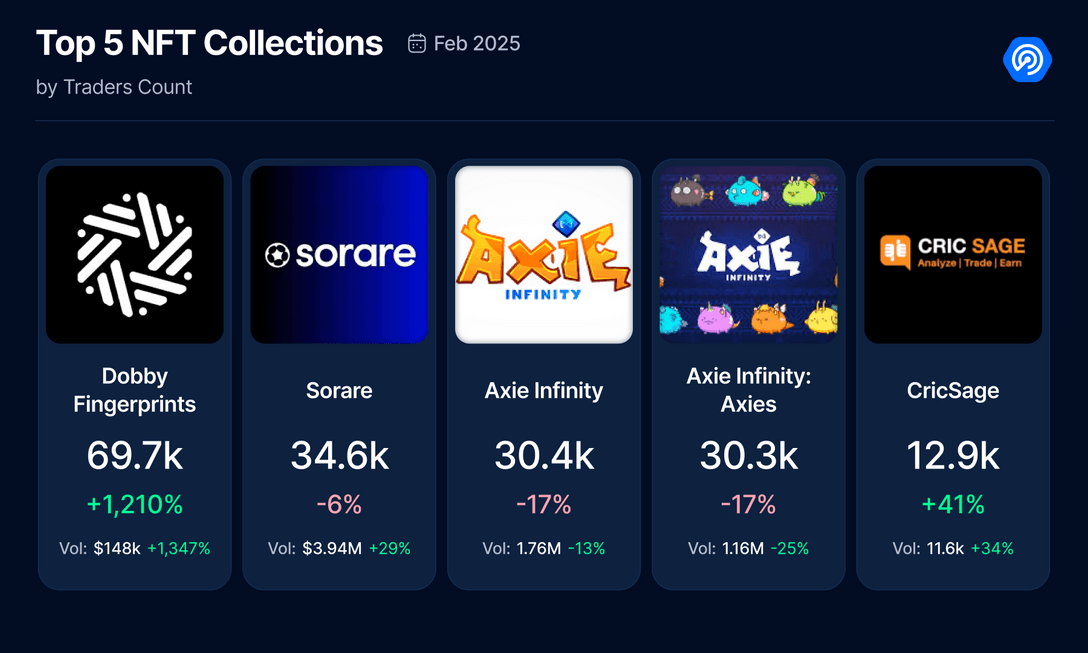
In addition to the broader AI trend dominating Web3, AI is increasingly being incorporated into NFT projects, marking a shift towards more dynamic, interactive, and useful digital assets.
In addition to AI, sports NFTs have also solidified their position as a dominant category. Sorare, a long-time leader in the sports NFT space, continues to thrive. However, new competitor CricSage offers a cricket-based opinion trading platform. This interactive approach to sports NFTs is sparking new engagement, especially among the cricket-loving community.
Analyzing the most traded NFT categories in February provides more insight into market trends:
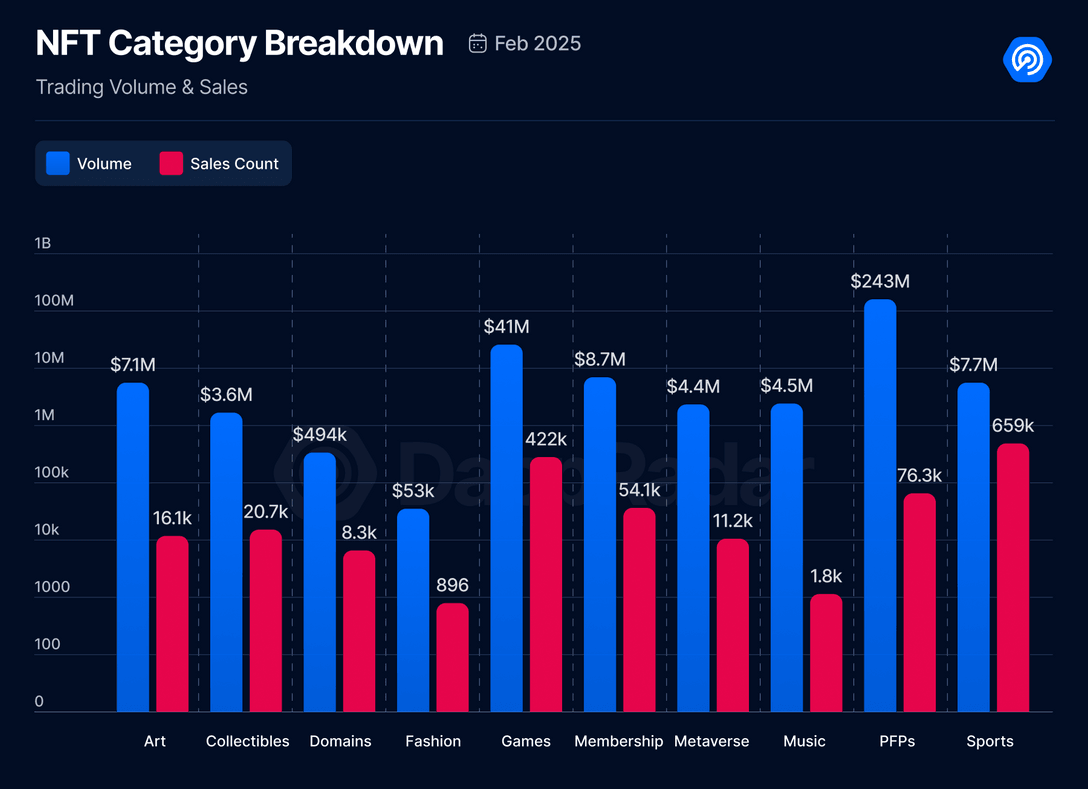
- The Profile Picture (PFP) NFT led the way in terms of trading volume, generating $243 million in 76,385 trades, with 99% of those occurring on Ethereum.
- Gaming NFTs ranked second in terms of trading volume, at $41 million, with 421,853 assets traded, primarily on ImmutableX (72%).
- Sports NFTs saw 659,097 transactions and $7.7 million in trading volume, with 98% of activity occurring on Starkware.
The evolving landscape suggests that while speculative trading may fluctuate, NFTs with strong utility, engagement, and real-world applications will drive long-term adoption of Web3.
Record month for crypto hacking attacks
February was the most disruptive month in crypto security history, with $1.5 billion stolen from decentralized platforms. This figure highlights the persistent gaps in Web3 security.
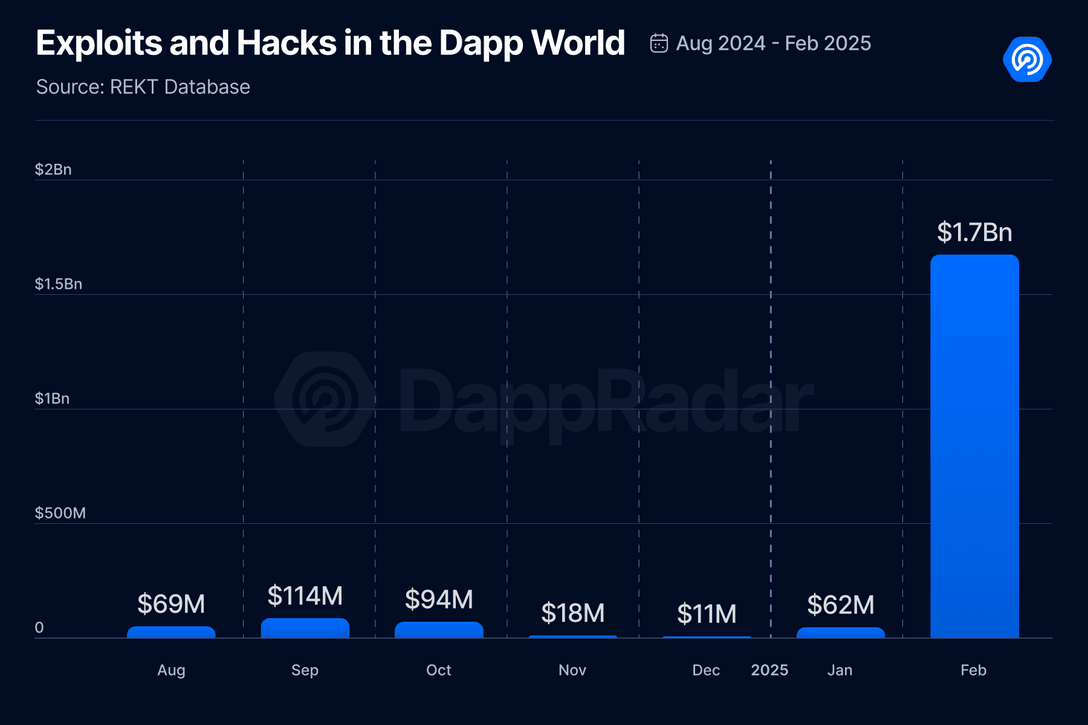
The record loss was primarily caused by the Bybit exchange hack, where the North Korean Lazarus Group hacker group exploited a multi-signature vulnerability to steal approximately $1.4 billion in cryptocurrency. The attack has now surpassed the 2022 Ronin bridge vulnerability to become the largest DeFi-related theft to date. The vulnerability sent shockwaves through the industry, reigniting concerns about the security of multi-signatures and the risks of centralized operations within exchanges and DeFi platforms.
In addition to Bybit, several other dapps fell victim to vulnerabilities in February. The zkLend lending protocol lost $9.5 million due to a mathematical error, exposing a critical flaw in the protocol’s design. Meanwhile, Ionic Money lost $8.6 million in a fake token collateral scam, further highlighting the ongoing risks associated with DeFi lending platforms.
Interestingly, almost all of these hacks stemmed from off-chain vulnerabilities, not on-chain ones. Attackers used social engineering tactics, compromised user interfaces, and malicious developers to gain unauthorized access, further demonstrating that Web3 security goes far beyond smart contract audits. The massive attack in February has revived calls for comprehensive security measures, urging platforms to prioritize operational security, multi-signature protection, and enhanced UI protections in addition to traditional smart contract audits.
As the Web3 landscape continues to evolve, these incidents serve as a reminder that even the most advanced blockchain ecosystems are vulnerable to sophisticated attacks. Strengthening security protocols, improving private key governance, and conducting more extensive risk assessments are critical to safeguarding the future of decentralized finance.
Conclusion
February demonstrated the dynamic and unpredictable nature of the Web3 landscape. While the industry has faced challenges (from a downturn in NFT trading to security breaches), innovation continues to bring new opportunities. The rise of AI-driven dapps, the resilience of the gaming and DeFi ecosystems, and the emergence of new chains highlight the industry’s adaptability and continued expansion.
As we move forward, security, sustainability, and user-driven innovation remain critical. The Web3 space is evolving rapidly, and every challenge brings a lesson that strengthens the foundation of decentralized technology. Whether through enhanced security measures, more intuitive AI integration, or the continued growth of community-driven projects, the decentralized future is still being written block by block.
Related reading: BitMart Research Institute VIP Investment Research Insights | Review of the Crypto Market in February
















